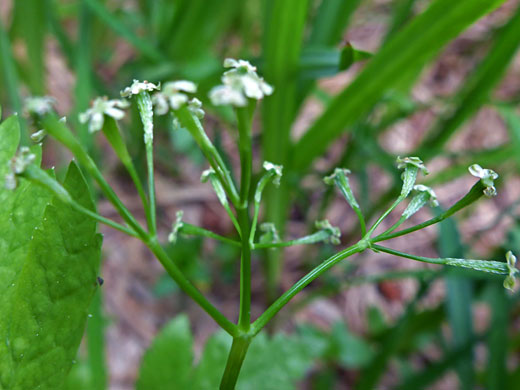Common names:
Bluntseed sweetroot, blunt-fruited sweet-cicely
Family:
Scientific name:
Osmorhiza depauperata
Main flower color:
Range:
The Four Corners states, and states to the north
Height:
Up to 30 inches
Habitat:
Aspen and pine woodland in mountainous regions, up to 11,000 feet
Leaves:
Up to 10 inches long; two or three times ternate; divided into broad leaflets, ovate to lanceolate, lined with large teeth
Season:
May to July
The light green leaves of osmorhiza depauperata are divided into relatively broad leaflets, lined by deep or shallow teeth. They, and all other plant parts, are usually hairless but may have a sparse covering of short hairs. This is a low-growing species, rather inconspicuous owing to its small flowers and habitat of shady woodland.
The inflorescence is attached by a stalk of up to 6 inches, and it consists of between two and five rays, up to 3 inches long, ascending, and each topped by around six flowers. These have a slender, unlobed, club-shaped (narrow at the base, becoming steadily wider towards the top) calyx, which lengthens (and darkens) to form the fruit, and five greenish-white petals. There are no bracts or bracteoles.
The inflorescence is attached by a stalk of up to 6 inches, and it consists of between two and five rays, up to 3 inches long, ascending, and each topped by around six flowers. These have a slender, unlobed, club-shaped (narrow at the base, becoming steadily wider towards the top) calyx, which lengthens (and darkens) to form the fruit, and five greenish-white petals. There are no bracts or bracteoles.
All Contents © Copyright The American Southwest | Comments and Questions | Contribute | Site Map



